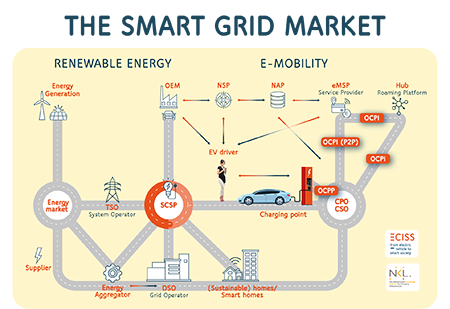When an electric vehicle is connected to a charging point, it forms part of the power grid. This means there are opportunities to use charging points for more purposes than just electricity consumption. However, this is dependent on a smooth flow of information between the various parties involved. The ECISS project has developed an architecture diagram to illustrate this.

ECISS stands for Emobility Communication & Information System Structure. The newly developed architecture diagram provides insight into the communication and information system for the smart energy market. The architecture connects the domains of Energy, Built Environment and Mobility. The roles of relevant players are shown in several concepts. The information flows run via an open protocol. Within the ECISS project this is the Open Charge Point Interface (OCPI). The diagram can be used as a connection and development tool.
Traditional communication regarding charging points
First of all, the diagram shows the traditional communication structure surrounding a charging point. EV drivers have a contract with the eMobility Service Provider (eMSP). So the eMSP knows when and for how long customers are charging their vehicles, it has contact with the Charge Point Operator (CPO), which is responsible not only for the technical maintenance of the charging point, but also for the administrative management, and thus has access to usage data. A third party that communicates with eMSP and CPO is the hub or roaming platform, which ensures that all EV drivers are able to use the charging point, regardless of their contract.
Extra link for smart charging
eMSP, CPO and roaming hub exchange data with each other to give EV drivers a trouble-free charging experience; all their communication is related to electricity consumption by the vehicle. However, if charging points are to be used for other purposes, an additional link is needed, namely to the Smart Charging Service Provider (SCSP). The SCSP is the connecting factor which is in direct contact with the local grid operator and, via the national grid operator, is also able to communicate with the energy market. The local and national grid operators appear on the diagram as DSO (Distribution System Operator) and TSO (Transmission System Operator) respectively.
How does the SCSP role work?
In the traditional situation, the charging session starts as soon as the car is connected to the charging point and stops when the battery is full. The SCSP, however, knows when there is a power peak (for example, when wind turbines are generating a lot) by communicating with the grid. It also knows via the DSO when there is high demand for power (for example, at the end of the working day, when a lot of people connect their cars at the same time and also start using electricity at home). The third flow of information comes from the EV drivers, as they set the time they will need their car again. If this is not until the following morning, the vehicle can be charged much more steadily, with lower power consumption if demand on the grid is high, and higher power consumption if there is a production peak. This extra link ensures that the management of power consumption can be much more refined.
Power supply back to the grid
However, smart charging means a lot more than just the smart regulation of power consumption. The battery of an electric car is also a power storage facility. There are already several pilots in which the car not only consumes power, but also supplies it back to the grid. Electric vehicles can then actually absorb peaks and troughs in the grid instead of amplifying them. The added role of the SCSP within an open protocol is also valuable for supplying power back to the grid.
Smart homes
Smart technology in the built environment is in rapid development and has therefore been included in the architecture diagram. The data flow that this technology produces offers a detailed picture of current household power consumption. The SCSP can use this to adjust the power consumption or supply accordingly. The CPO can also use the data supplied by home charging points to ensure balanced energy consumption.
Roles and organisations
EMSP and CPO are shown as separate organisations on the architecture diagram. In practice, however, these roles can be combined in a single company. The role of SCSP can also be taken on within a company that already has the role of eMSP and/or CPO.
Architecture diagram in practice
Project partner TNO has developed this architecture diagram in cooperation with ECISS partners Jedlix, Greenflux, Eneco, Allego and NKL. The communication flows have been tested by adding the SCSP role to the topology of the OCPI open protocol.
Share your ideas!
We invite everyone to use this reference architecture, to reflect and to provide feedback. If you have any comments, please share them with ECISS: eciss@nklnederland.nl
For technicians: see the detailed version of the architecture diagram
ECISS receives funding from TKI Urban Energy







